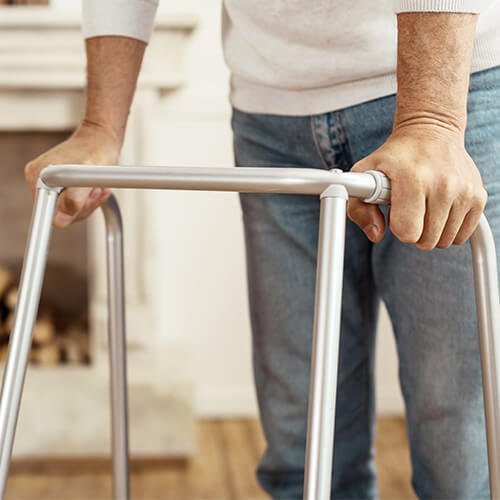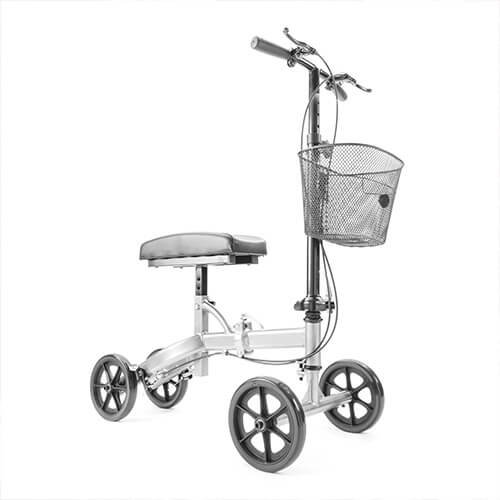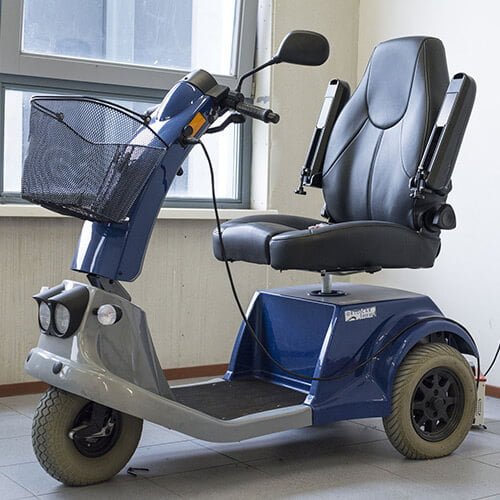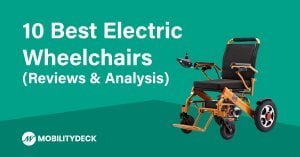- Senior Living
- Our Quality Guarantee
- Last Updated November 30, 2025

Types of Walking Assistance Devices for Seniors
There are many walking assistance devices and mobility aids designed to help elderly people who have problems moving around safely. The likelihood of falling as one grows older increases quite a bit, and a fall can be dangerous, so it makes sense that various walking aids have been developed to provide safety and support to those who need it.
There are so many mobility aids and walking devices available today that while there will be something out there to meet everyone’s needs, it’s hard for many to figure out where to start! An industry that began with simple aids such as a walking stick (commonly called a cane) has developed crutches, walkers, rollators, knee scooters, and more. Given all the options, It can be unsafe when first researching walking devices!
Thankfully, we have compiled this guide to all the common types of walking assistance devices for elderly people available today. We hope this guide gives you a starting point for understanding precisely what products are out there and how they can help you:
In This Article
9. Types of Walking Mobility Aids for Elderly People
1. Canes
Canes are the most common and standard type of walking aid a senior is likely to use. By the time most of us reach our seventies, our balance will be starting to falter, and a cane can help for stability while reducing strain on the legs and being an easy, portable device to keep around. Most canes come in a “standard” length of 36 inches, a great height for most, but one that can be adjusted to the user’s needs.
If you ever feel at risk of falling, a cane can be handy as a non-intrusive device that still allows for much independence. Like crutches, canes help support the body’s weight and help transfer some of the load from the legs to the upper body.
One thing to note with canes is that although they take the strain off the lower body to assist with walking, they place more pressure on the hands and wrists. So, if you have weaker upper body or arm/hand issues, a cane is the best walking device if you only intend to use it sparingly. Despite this, in the USA, 1/10 seniors over 65 use one – so they must have some great positives!
Common Types of Canes
- Quad canes:
Quad canes are a heavier and more stable type of cane with four feet at the bottom of the stick. These make them an excellent walking device for those with more severe balance/stability issues. - Forearm Canes:
Forearm canes are a type of cane that offers extra support for the forearms by having an extension to take some of the weight from the hands and wrists and transfer it to the upper arm. These are also commonly known as crutches (discussed below) and are great walking assistance devices when transferring pressure from the lower body to the upper body. - Adjustable Canes:
As mentioned above, some canes have adjustable lengths. These are useful in some circumstances but are usually less stable than standard canes. Generally speaking, we suggest people look for an adequately measured standard cane before looking at adjustable options.
Check out our guide to the different tyles of canes for walking.
2. Crutches

Crutches are designed to support your weight and increase your stability while walking. These assistive devices transfer some weight from your legs to your upper body, enabling you to move around more easily.
Using crutches can provide added support as you work on regaining strength and mobility, reducing the risk of falls by enhancing your overall balance. When choosing crutches, selecting ones that fit comfortably and provide proper support for a safer walking experience is essential.
By distributing your body weight more evenly, crutches can help minimize strain on injured or weakened lower extremities, allowing you to maintain an active lifestyle with reduced discomfort.
3. Walkers

Walkers, also known as Zimmer frames, have a metal frame with four legs. Sometimes, they will have wheels on the two front legs to make forward movement easier. There are also different types of walkers, including 2-wheel and rollator walkers (discussed at 4).
Walkers provide more support and balance than canes and crutches because they have broader contact with the ground. The user will generally place weight on the two sides of the frame, receiving great stability while maintaining a fair level of independence.
Despite being larger than canes and crutches, walkers are still generally lightweight and often foldable. In some cases, a walker can be even lighter than crutches!
However, as far as walking devices for the elderly go, walkers are not always the best option. They are often challenging to maneuver when out and about when there is little difference in the height of the pavement and other similar obstructions. For this reason, if you’re looking for a walking aid to help you when outside the home – walkers might not be the best option.
Recommended Walkers
| Editor's Picks | Walker | Rating |
|---|---|---|
| 1. Best Overall Walker for Seniors | Helavo Bariatric Walker with Large Seat | 4.7/5 |
| 2. Best Lightweight Walker | Hugo Mobility Explore Side-Fold Rollator Walker | 4.5/5 |
| 3. Best Narrow Walker | Planetwalk Premium 3 Wheel Rollator | 4.6/5 |
| 4. Best Budget Pick | /Medline Folding Rollator: Seat & 6" Wheels Included | 4.5/5 |
| 5. Best Standard Walker | OasisSpace Compact Folding Walker | 4.6/5 |
4. Rollators

While the Zimmer frame is the most basic form of a walker, there are others, such as rollators.
Rollators have a frame with four wheels, handlebars, and often a seat where the user may rest when desired. Given the number of wheels, rollators typically have hand brakes for additional safety.
Rollators are especially useful for seniors who need more walking support than average but do not want to consider a wheelchair. They provide great safety and stability for the user, but their size, weight, and bulkiness can cause issues during day-to-day use, like walkers.
5. Knee Scooters

While similar to a rollator, the knee scooter/walker has been designed to allow the user to rest one knee on a padded cushion while propelling the walker with the other leg.
Knee scooters are an especially great walking aid if you have only injured one leg or if you want a walking device that allows you to stay active. They’re fun to use, too, but there are better options for those with general weakness/limited mobility.
To learn more about them, check out our guide to the best knee scooters.
Recommended Knee Scooters
| Editor's Picks | Knee Scooters | Rating |
|---|---|---|
| 1. Best Overall | KneeRover GO Knee Walker | 4.3/5 |
| 2. Runner Up | KneeRover Deluxe Steerable Knee Scooter | 4.5/5 |
| 3. Best Heavy Duty | All Terrain KneeRover Steerable Knee Scooter | 4.3/5 |
| 4. Best For Elderly | Drive Medical DV8 Aluminum Steerable Knee Walker | 4.2/5 |
| 5. Best Budget Pick | KneeRover Economy Steerable Knee Scooter | 4.4/5 |
6. Wheelchairs

Unlike most walking assistance devices that give the user some work, a wheelchair moves for you – especially if you choose an electric wheelchair! A wheelchair is best used by those who should not or cannot put weight on their lower limbs or cannot walk. The wheelchair can be the right mobility aid for those with more severe disabilities or who need to travel greater distances.
Recommended Wheelchairs
| Editor's Picks | Wheelchair | Rating |
|---|---|---|
| 1. Top Wheelchair Pick | Hi-Fortune Lightweight 21 lbs. Wheelchair | 4.6/5 |
| 2. Best Motorized Wheelchair | HVREGHY 10 Miles Electric Wheelchair | 4.4/5 |
| 3. Best Wheelchair for Seniors | Medline Lightweight & User-Friendly Wheelchair | 4.2/5 |
| 4. Best Lightweight Wheelchair | Karman Ergonomic Ultra Lightweight Wheelchair | 4.6/5 |
| 5. Best Budget Wheelchair Pick | Drive Medical Cruiser III Light Weight | 4.4/5 |
7. Mobility Scooters

While they’re similar to wheelchairs, mobility scooters are bulkier machines, usually designed to be battery-powered outdoors and with steering controls. Again, like wheelchairs, mobility scooters are not so much “walking assistance devices” as they are walking replacement devices! But they can be great for those who have trouble getting out and about.
8. Transfer Devices
Transfer devices are vital for assisting individuals with mobility challenges in safely moving from one surface to another, such as from a wheelchair to a bed. These devices significantly reduce the risk of falls and help promote safe and efficient transfers for older people and those with limited mobility.
Incorporating transfer devices into care plans is crucial, as they are pivotal in enhancing safety and independence while minimizing the potential for injury. By understanding and utilizing different types of transfer devices, individuals can receive the necessary support needed for smooth transitions, ultimately improving their overall mobility and well-being.
For seniors or individuals with mobility limitations, embracing these transfer devices is essential for maintaining an active lifestyle with reduced risk of accidents during daily activities.
9. Gait Trainers
Gait trainers provide increased stability, making them suitable for individuals needing more support than canes or crutches. These devices are designed to promote proper posture and gait while helping you maintain balance and prevent falls.
Robotic walkers that directly interact with users are also available to assist with walking and fall prevention, offering advanced technology to support your mobility needs. When selecting a gait trainer, consider the level of stability it provides and how well it meets your specific mobility requirements as an elderly individual seeking assistance in walking and maintaining stability.
Consider factors such as comfort, ease of use, and the device’s adaptability to different environments when choosing a gait trainer. Seek professional advice when choosing the most suitable walking aid for your needs.
Other Options for Walking Assistance
While the above outlines the types of walking assistance devices available for elderly people today, they are not the only options! There is a wide variety of alternatives to a walking assistance device to consider when thinking about improving your stability and independence when walking:
Ramps
Ramps, while great for assisting anyone with walking, can be essential for those using wheelchairs and scooters. Those who use walkers, canes, or crutches also find that ramps make access much more accessible.
Stair Lifts
A stair lift can be installed in almost any home. This device has a seat with control. The user sits on the seat, and using the power, the seat will move up the staircase or down, permitting easy access to the different floors of a home or office without having to tackle them by foot.
Hand Rails
Sturdy handrails, such as bathtubs, toilets, and other office locations, may be installed almost anywhere needed within a home to make the risk of falling much less likely and provide support when moving around.
Choosing the Right Walking Aid
When choosing the right walking aid, assessing your mobility needs and seeking professional advice is essential. Consider your budget and comfort as well. Keep reading for more information on finding the perfect walking-a-loved one aid.
Assess Mobility Needs
Assessing your mobility needs is crucial for choosing the right walking aid:
- Consider your daily activities and how a walking aid can support them.
- Evaluate your balance and stability to determine the level of assistance required.
- Consider any pain or discomfort when walking, identifying areas where support is needed.
- Assess the environment where you will be using the walking aid to ensure it suits your surroundings.
- Consult a healthcare professional for personalized advice based on your specific mobility challenges.
- Factor in your budget while considering the long-term benefits of investing in the right walking aid.
- Ensure the chosen device aligns with your comfort and physical capabilities for enhanced use.
Seek Professional Advice
Assessing your mobility needs can be overwhelming, but seeking professional advice is essential. Professional guidance ensures that your walking aid meets your specific requirements and promotes safety.
Their expertise will help you make an informed decision based on individual needs, ultimately enhancing the effectiveness of the chosen walking aid.
Seeking professional advice guarantees that the selected mobility aid suits your unique circumstances. It’s crucial in ensuring your safety and enhancing your overall mobility and independence.
Consider Budget and Comfort
When choosing a walking aid, it’s essential to consider budget and comfort. Assess your mobility needs while also considering the cost associated with different types of aids.
Seek professional advice to ensure that the chosen aid meets your specific requirements. Remember that balancing cost and comfort is crucial when making this decision, as you want to invest in a device that promotes mobility while providing the necessary support and ease of use.
Comfort should not be overlooked when selecting a walking aid for elderly individuals. The right aid should offer stability and convenience without compromising comfort, ensuring seniors’ improved quality of life.
Risks to Consider
As with any tool, walking assistance devices come with risks. For example, underarm crutches are known to lead to a condition known as crutch paralysis, which is caused by excess pressure on the nerves in the armpit.
Improper use of mobility aids may also lead to other injuries. Seniors are especially at risk of falling and causing serious injury to themselves when using devices they have not been trained to operate correctly. Given that only about one-third of all users receive their mobility aids from a medical professional, this is a significant risk to consider.
Thankfully, this risk is easily mitigated: As with all the content on our site, it is sound advice to make an appointment with a doctor or physical therapist to learn the proper use of your device and the best option before making a purchase.
FAQs
1. What are walking aids for elderly?
Walking aids for older people include assistive devices like walkers, canes, and rollators that help seniors move around safely and prevent falls.
2. Why are mobility aids important for the elderly?
Mobility aids are essential because they promote independence, support balance, and reduce the risk of falling among older adults.
3. Can walking supports really prevent falls in seniors?
Yes! Fall prevention devices like grab bars and non-slip mats work alongside mobility aids to help seniors maintain stability and avoid accidents.
4. What kinds of walking assistance devices are available for disabled individuals?
There is a range of walking assistance equipment, including crutches, knee scooters, and specialized walkers designed to cater to the needs of disabled individuals.
5. How do I choose the right elderly walking aid for balance issues?
When selecting an assistive device for an older adult with balance problems, consider their specific mobility requirements, comfort levels with different aids, and advice from healthcare professionals on functional mobility devices that would suit them best.
6. Where can I find elderly mobility aids near me?
You can find senior mobility aids at medical supply stores or through online retailers specializing in geriatric assistive devices aimed at improving safety and daily living for older adults.
More Mobility Articles:
Articles You May be Interested In:



















